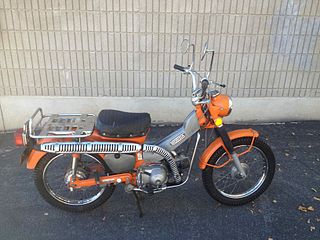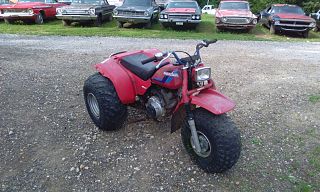
Acura is the luxury and performance division of Japanese automaker Honda, based primarily in North America. The brand was launched on March 27, 1986, marketing luxury and performance automobiles. Acura sells cars in the United States, Canada, Mexico, Panama, and Kuwait. The company has also previously sold cars in China, Hong Kong, Russia, and Ukraine. Plans to introduce Acura to the Japanese domestic market in the late 2000s did not eventuate due to the financial crisis of 2007–2008.

An automatic transmission is a multi-speed transmission used in motor vehicles that does not require any input from the driver to change forward gears under normal driving conditions. Vehicles with internal combustion engines, unlike electric vehicles, require the engine to operate in a narrow range of rates of rotation, requiring a gearbox, operated manually or automatically, to drive the wheels over a wide range of speeds.

An all-terrain vehicle (ATV), also known as a light utility vehicle (LUV), a quad bike or quad, as defined by the American National Standards Institute (ANSI), is a vehicle that travels on low-pressure tires, has a seat that is straddled by the operator, and has handlebars. As the name implies, it is designed to handle a wider variety of terrain than most other vehicles. It is street-legal in some countries, but not in most states, territories and provinces of Australia, the United States, and Canada.

Four-wheel drive, also called 4×4 or 4WD, refers to a two-axled vehicle drivetrain capable of providing torque to all of its wheels simultaneously. It may be full-time or on-demand, and is typically linked via a transfer case providing an additional output drive shaft and, in many instances, additional gear ranges.

The Acura TL is an executive car that was manufactured by Acura, the luxury division of Honda. It was introduced in 1995 to replace the Acura Vigor and was badged for the Japanese-market from 1996 to 2000 as the Honda Inspire and from 1996 to 2004 as the Honda Saber. The TL was Acura's best-selling model until it was outsold by the MDX in 2007. In 2005, it ranked as the second best-selling luxury sedan in the United States behind the BMW 3 Series, but sales decreased after the 2008 model year. Four generations of the Acura TL were produced, with the final fourth generation TL premiering in 2008 as a 2009 model and ending production in 2014, when it was replaced together with the TSX by the TLX.

A manual transmission (MT), also known as manual gearbox, standard transmission, or stick shift, is a multi-speed motor vehicle transmission system, where gear changes require the driver to manually select the gears by operating a gear stick and clutch.
A semi-automatic transmission is a multiple-speed transmission where part of its operation is automated, but the driver's input is still required to launch the vehicle from a standstill and to manually change gears. Semi-automatic transmissions were almost exclusively used in motorcycles and are based on conventional manual transmissions or sequential manual transmissions, but use an automatic clutch system. But some semi-automatic transmissions have also been based on standard hydraulic automatic transmissions with torque converters and planetary gearsets.
A minibike is a two-wheeled, motorized, off-highway recreational vehicle popularized in the 1960s and 1970s, but available continuously from a wide variety of manufacturers since 1959. Their off-highway nature and typically entirely off-road legal status differentiate minibikes from motorcycles and mopeds, and their miniature size differentiates them from dirt bikes.
ATTESA is a four-wheel drive system used in some automobiles produced by the Japanese automaker Nissan, including some models under its luxury marque Infiniti.

The Honda CT90 was a small step-through motorcycle manufactured by Honda from 1966 to 1979. It was offered in two models: Trail or X with the main variations being gear ratios and tyre style.

An amphibious all-terrain vehicle, amphibious ATV, is a small, all-wheel drive, all-terrain amphibious vehicle, used for recreation, farm-, hunting, utility or industry tasks, by enthusiasts and professionals worldwide. They are legally off-highway vehicles in many countries, or at least restricted from use on express highways and motorways – their use is generally extra-urban.
The Honda Rancher is an All-Terrain Vehicle manufactured by Honda, and is one of the model line of ATV's. Currently there are two generations of the TRX420 which differ significantly in design and features.

The Honda VFR1200F is the 7th generation Honda sport touring motorcycle from the VF and VFR line motorcycles powered by a transverse mounted V4 engine. The VFR1200F has several new technologies including the first dual clutch transmission offered on a motorcycle.

A dual-clutch transmission (DCT) is a type of multi-speed vehicle transmission system, that uses two separate clutches for odd and even gear sets. The design is often similar to two separate manual transmissions with their respective clutches contained within one housing, and working as one unit. In car and truck applications, the DCT functions as an automatic transmission, requiring no driver input to change gears.

The Acura RLX is a mid-size flagship luxury car manufactured by Honda and sold under their Acura division, released in 2013, succeeding the RL. The RLX was discontinued in 2020.

The Acura TLX is a four-door entry-level luxury sedan sold by Acura, a luxury division of Honda, since 2014. It is the successor to both the TL and TSX models. As of 2021, the discontinuation of the RLX leaves the TLX as the flagship sedan in Acura's lineup.

The Honda ATC200 is an all-terrain vehicle that was introduced in 1981 as Honda's top model in the ATC line-up, remaining, in various forms, until Honda voluntarily ceased production in 1987. In the six years of production, six variations were made, often sold concurrently. Collectively, Honda produced over 530,000 ATC200 vehicles, becoming the most prolific sellers in the ATC market, and one of the most recognizable ATCs available.
Honda Sport ATCs, produced until 1987, were built specifically for performance, and designed for use in racing, or for aggressive trail riding. The machines lacked luggage racks and other utilitarian features, commonplace on most other ATCs or ATVs.
The Honda ATC125M was a three-wheeled All Terrain Cycle released in 1984, and received a major revision in 1986. The model was sold through 1987, when Honda voluntarily discontinued sales of ATC's. The first iteration can trace its development back to Honda's first ATC, the Honda US90, released in 1970, while the second iteration borrowed heavily from the ATC200 line.













